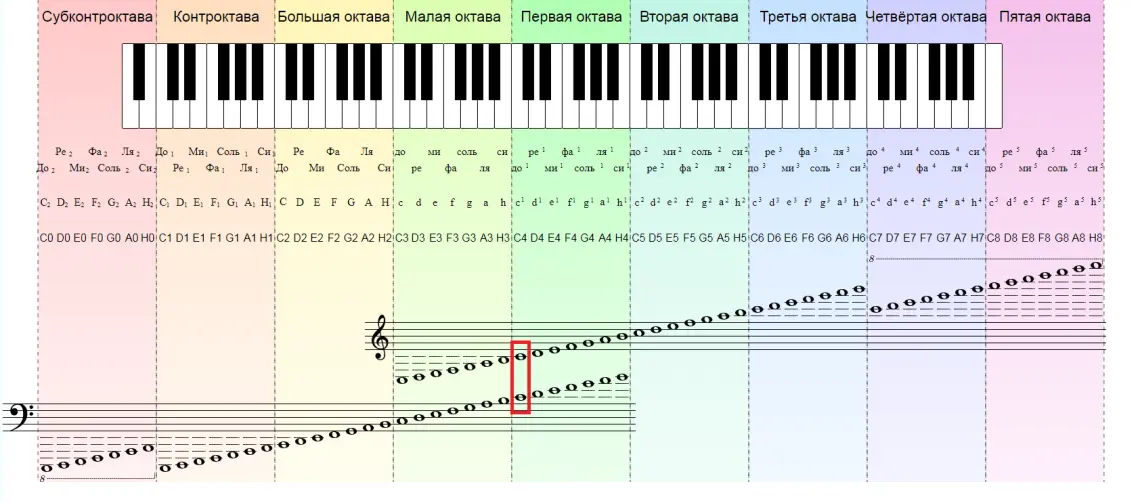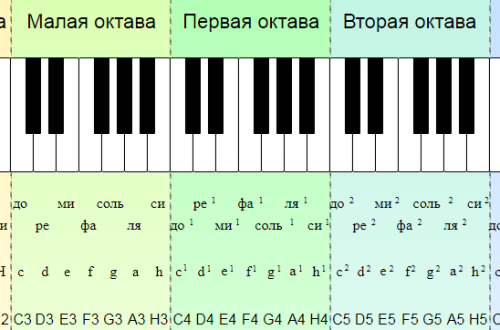
Recording and playing music notation (Lesson 4)
In the last, third lesson, we studied major scales, intervals, steady steps, singing. In our new lesson, we will finally try to read the letters that composers are trying to convey to us. You already know how to distinguish notes from one another and determine their duration, but this is not enough to play a real piece of music. That’s what we’ll talk about today.
To get started, try playing this simple piece:
Well, did you know? This is an excerpt from the children’s song “The little Christmas tree is cold in winter.” If you learned and were able to reproduce, then you are moving in the right direction.
Let’s make it a little more difficult and add another stave. After all, we have two hands, and each has one staff. Let’s play the same passage, but with two hands:
Let’s continue. As you may have noticed, in the previous passage, both staves begin with the treble clef. This will not always be the case. In most cases, the right hand plays the treble clef and the left hand plays the bass clef. You will need to learn to separate these concepts. Let’s get on with it right now.
And the first thing you will need to do is to learn the location of the notes in the bass clef.
Bass (key Fa) means that the sound of the small octave fa is written on the fourth line. The two bold dots included in his image must span the fourth line.

Look at how bass and treble clef notes are written and I hope you understand the difference.

![]()
![]()
And here is our familiar song “It’s cold in the winter for a little Christmas tree”, but recorded in a bass key and transferred to a small octave  Play it with your left hand to get used to writing music in the bass clef a little.
Play it with your left hand to get used to writing music in the bass clef a little.

Well, how did you get used to it? And now let’s try to combine in one work two clefs already familiar to us – violin and bass. At first, of course, it will be difficult – it’s like reading at the same time in two languages. But don’t panic: practice, practice and more practice will help you get comfortable with playing in two keys at the same time.
It’s time for the first example. I hasten to warn you – do not try to play with two hands at once – a normal person is unlikely to succeed. Disassemble the right hand first, and then the left. After you learn both parts, you can combine them together. Well, let’s get started? Let’s try to play something interesting, like this:
Well, if people started dancing to the accompaniment of your tango, it means that your business is going uphill, and if not, do not despair. There may be several reasons for this: either your environment does not know how to dance :), or everything is ahead of you, you just need to make more efforts, and then everything will definitely work out.
Until now, musical examples have been works with a simple rhythm. Now let’s learn more complex drawing. Don’t be scared, no big deal. It’s not that much more complex.
We used to play mostly the same duration. In addition to the main durations with which we have already become acquainted, signs are also used in musical notation that increase durations.
These include:
a) point, which increases the given duration by half; it is placed to the right of the head of the note:
b) two points, increasing the given duration by half and another quarter of its main duration:
at) league – an arcuate line connecting adjacent note durations of the same height:
d) fermata – a sign denoting an indefinitely strong increase in duration. For some reason, many people smile when they meet this sign. Yes, indeed, the duration of the notes must be increased, but all this is done within reasonable limits. Otherwise, you can increase it like this: “… and then I’ll play tomorrow.” The fermata is a small semicircle with a dot in the middle of the bend:
From what you need, perhaps it is worth recalling what they look like pauses.
To increase the duration of pauses, dots and fermats are used, as well as for notes. Their meaning in this case is the same. Only leagues for pauses do not apply. If necessary, you can put several pauses in a row and not worry about anything else.
Well, let’s try to put what we learned into practice:
Notes of the song L`Italiano by Toto Cutugno
And finally, I want to introduce you to the signs of abbreviation of musical notation:
- Repeat sign – reprise () – is used when repeating any part of a work or the whole, usually a small, work, for example, a folk song. If, according to the composer’s intention, this repetition should be performed without changes, exactly as for the first time, then the author does not write the entire musical text again, but replaces it with a reprise sign.
- If during repetition the end of a given part or the whole work changes, then a square horizontal bracket is placed above the changing measures, which is called “volta”. Please do not be afraid and not to be confused with electrical voltage. It means that the whole play or part of it is repeated. When repeating, you do not need to play the musical material located under the first volt, but you should immediately go to the second.
Let’s look at an example. Playing from the start, we reach the mark “replay”.“(I remind you that this is a sign of repetition), we start playing again from the very beginning, as soon as we finish playing to the 1st volts, immediately “jump” to the second. Volt can be more, depending on the mood of the composer. So he wanted, you know, to repeat five times, but each time with a different ending to the musical phrase. That’s 5 volts.
There are also volts “For repeat” и “For the End”. Such volts are mainly used for songs (verses).
And now we will carefully consider the musical text, mentally note that the size is four quarters (that is, there are 4 beats in the measure and they are quarters in duration), with the key of one flat – si (do not forget that the action of the flat applies to all notes “si ” in this work). Let’s make a “game plan”, i.e. where and what we will repeat, and … forward, friends!
The song “Et si tu n’existais pas” by J. Dassin



